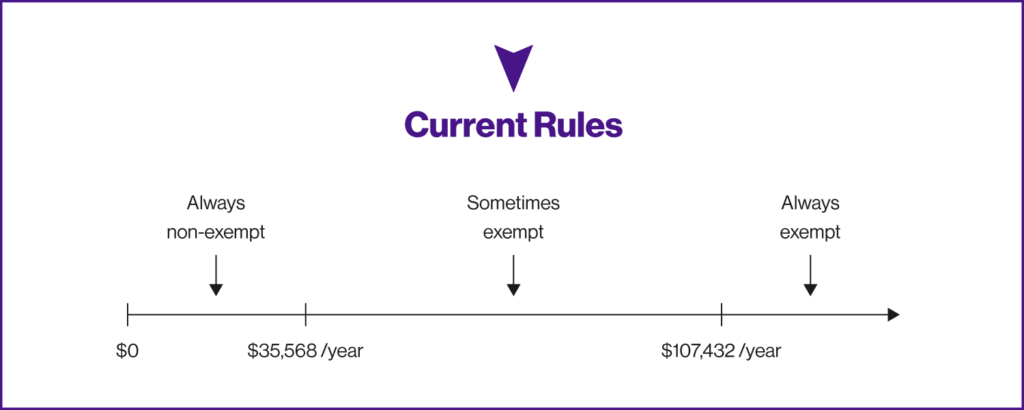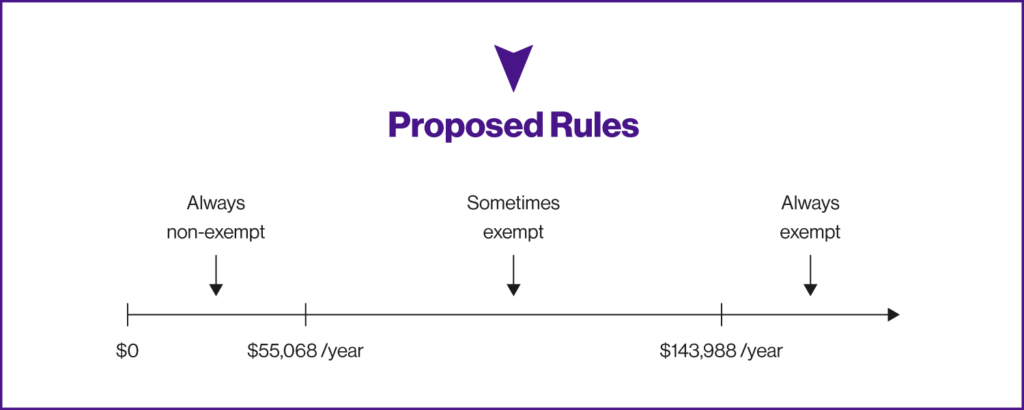In August 2023, the Department of Labor proposed changing pay thresholds governing exempt vs. non exempt employees from protections under the Fair Labor Standards Act (FLSA).
Should the change proceed, 3.4 million additional employees could be entitled to overtime pay.
This change is not something for startups and small businesses to take lightly.
Misclassifying employees as exempt can be an expensive headache for business owners. In case this change occurs, employers should refresh their understanding of FLSA classification rules and ensure they remain compliant with the law.
If you’d like personalized help, consider contacting indinero’s outsourced accounting services team.
Table of Contents
What Is an Exempt Employee?
Exempt employees are “exempt” from specific provisions of the Fair Labor Standards Act. They are excluded from receiving overtime pay if they put in more than 40 hours of work within one week.
In most cases, exempt employees are salaried and perform job duties without supervision or strict adherence to a set number of working hours.
What Is a Non Exempt Employee?
Non exempt employees are entitled to overtime pay if they exceed 40 working hours a week. These employees are the ones protected by the provisions of the FLSA, which ensures pay for those additional hours as well as a standard minimum wage. Non exempt employees are usually paid hourly; common examples include clerical, administrative, or manual labor work.
What Is the Difference Between an Exempt and a Non Exempt Employee?
There are a handful of specific tests the Department of Labor (DOL) uses to differentiate employees. We’ll outline them in detail below, but the bottom line for business owners is that non exempt employees are entitled to time and a half of overtime pay for all hours worked over 40 in a given week.
Failure to comply with the FLSA comes with a $1000 penalty per violation; violations are tallied on a per-employee and per-pay-period basis, which means they can rack up quickly if employers aren’t adhering to the rules.
Exempt Employee Rules
The most important question for remaining FLSA compliant is: “Are my employees exempted?”
The DOL uses three tests to classify exemption; an employee must pass all three to be excluded from the FLSA:
- Gross pay
- Salary basis
- Duties test
Exempt Employee Gross Pay Rules
The FLSA is cut and dry for some pay thresholds. As of October 25, 2023, the exempt employee minimum threshold is $35,568 annually. Anyone earning below that figure is non exempt while those earning above $107,432 are always exempt.

If the rule change goes forward, the automatic thresholds will shift to $55,068 for non exempt employees and $143,988 for exempt.

Should your employee fall between these figures, the other two tests will determine exemption status.
Salary Basis
The next test is whether or not an employee is paid on salary. If not, they’re automatically non exempt. If so, one test remains to verify that an employee is indeed exempted.
Whether or not a worker is paid on a salary basis is pretty straightforward. Still, it’s worthwhile to consider the way the FLSA defines a “salary.”
An employee receives a salary when they have a guaranteed minimum sum of money they can expect for any work week in which they complete any tasks. This sum doesn’t have to be their total compensation (for instance, bonuses may be included), but there should be a certain amount the employee is assured of getting in any workweek they perform tasks.
Other indicators suggesting an employee is salaried include calculating their base pay from an annual total divided by the yearly pay periods or if their actual pay decreases when they work fewer hours than usual.
There are also some rather complicated rules around permissible reductions in pay that are outside the scope of this article. If you have questions, consider contacting an indinero accounting services representative, and one of our experts will be happy to provide guidance.
Duties Test
In addition to the gross wage and salary-basis tests, the FLSA outlines specific tasks employees must perform to be considered exempt. The law refers to these criteria as the “duties test” and emphasizes that duties are based on job function, not employee title.
The FLSA considers “learned professions” to be exempt jobs.* They range from executives, managers, finance professionals, doctors, attorneys, outside salespeople, and individuals with specialized technological expertise. These roles have several things in common that align with the duties test. They each:
- Can operate independently or with little to no supervision
- Make important company decisions (including spending and expense choices)
- Typically manage others or their own teams
- Often are highly compensated
Individuals like these are held responsible for the livelihood of their respective parts of the business. They are exempt because they’ve proven their area of expertise, and when all else fails, they are the ones who can bring projects to fruition in the moment of truth.
*These guidelines are used federally as a minimum standard. Be sure to check with your state legislature because some may have more stringent definitions.
Is a Salary Employee Exempt or Non Exempt?
If an employee also meets both the gross pay and duties requirements, salaried employees are exempt.
Is an Hourly Employee Exempt or Non Exempt?
Generally, they are non exempt and protected by the Fair Labor Standards Act.
Exceptions to the FLSA
The FLSA covers most workers in the United States. However, the law itself explicitly excludes movie theater employees and agricultural workers. Additionally, any job explicitly governed by another law supersedes the FLSA. For example, railroad workers fall under The Railway Labor Act and, therefore, are not governed by FLSA rules.
Conclusion
Distinguishing between exempt and non exempt employees is important for remaining compliant with the Fair Labor Standards Act. To avoid costly penalties for misclassification, be sure to understand the criteria: gross pay thresholds, salary basis pay, and specific job duties for exempted employees.
If you’re a growing business and would like help with accounting questions like this or help preparing for tax season, our accounting services team is ready to help.




